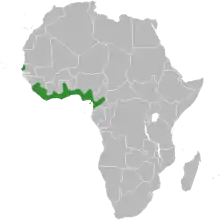Baphia nitida
Baphia nitida, also known as camwood, barwood, and African sandalwood (although not a true sandalwood), is a shrubby, leguminous, hard-wooded tree from central west Africa. It is a small understorey, evergreen tree, often planted in villages, and known as osun in Yoruba.
| Baphia nitida | |
|---|---|
.jpg.webp) | |
| Scientific classification | |
| Kingdom: | Plantae |
| Clade: | Tracheophytes |
| Clade: | Angiosperms |
| Clade: | Eudicots |
| Clade: | Rosids |
| Order: | Fabales |
| Family: | Fabaceae |
| Subfamily: | Faboideae |
| Genus: | Baphia |
| Species: | B. nitida |
| Binomial name | |
| Baphia nitida Lodd. | |
 | |
| The distribution of Baphia nitida. | |
| Synonyms[1] | |
| |
The wood is of a very fine colour, and is used in woodturning for making knife handles and similar articles. The tree's bark and heartwood are commonly used to make a brilliant but non-permanent red dye, which is soluble in alkali.
Pterocarpin is a pterocarpan found in B. nitida.[2]
Osun (camwood) extract is also used in some soaps and skin treatments, primarily among the Yoruba people of West Africa. The extract of the Camwood can be formed into a soft soap like material that is thought to promote healthy skin.
References
- Soladoye MO (1985). "A revision of Baphia (Leguminosae-Papilionoideae)". Kew Bulletin. 40 (2): 291–386. doi:10.2307/4108263. JSTOR 4108263.
- "Pterocarpin at knapsack_jsp". Archived from the original on 2014-02-22. Retrieved 2013-02-05.
External links
- VIRBOGA - Baphia nitida
- Dressler, S.; Schmidt, M. & Zizka, G. (2014). "Baphia nitida". African plants – a Photo Guide. Frankfurt/Main: Forschungsinstitut Senckenberg.
- . The American Cyclopædia. 1879.
